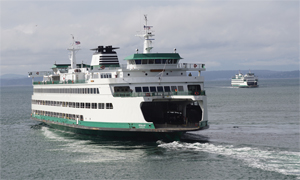Washington State Ferries (WSF) Capt. Joel Michelson barely finished explaining how every Elliott Bay passage is a little different when he got a message proving his point. Down below, a passenger was unconscious and suffering a seizure.
Michelson increased Puyallup’s speed to about 19 knots to hasten its arrival into downtown Seattle. For 90 tense seconds, he coordinated the emergency response with the crew and made arrangements for paramedics to meet the ship at the dock. Finally, word came that the man was conscious and stable. Michelson gave a reassuring look to the wheelhouse personnel. “OK,” the captain said, “he’s awake.”
“We have medical emergencies often,” said Michelson, an 18-year ferry system employee. “When you move this many thousands of people, you are going to get heart attacks, seizures, you name it. I think I have seen everything except somebody giving birth, but other (crewmembers) have.”
WSF is the largest ferry operator in the United States. Its 22 passenger and vehicle ferries carried nearly 24 million people in 2019. The system’s 1,900 employees include hundreds of mariners working in the wheelhouse, on deck and below in the engine rooms.
Michelson led 15 crew aboard Puyallup on a brisk, breezy late February day. Morning fog nearly burned off by the 0935 departure from Colman Dock in downtown Seattle to Bainbridge Island. The roughly 6.5-mile run across Elliott Bay takes 35 minutes each way, and the ferries run almost 20 hours a day.
Puyallup is one of three Jumbo Mark II-class ferries. They are the largest in the WSF fleet and the second largest double-ended ferries in the world. The 460-foot behemoths can hold 202 vehicles and 2,499 passengers. Tacoma and Wenatchee are the other two in the class. All three were built in the late 1990s.
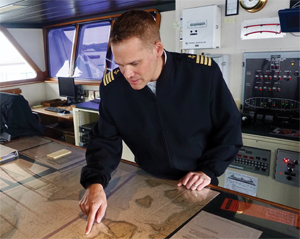 |
|
Puyallup Capt. Joel Michelson describes the S-turn leading into Eagle Harbor, home to the WSF terminal on Bainbridge Island. |
Michelson was describing Puyallup’s attributes when chief mate Mike Edwards, positioned about 250 feet away in the aft-facing wheelhouse, guided the vessel off Colman Dock. The crossing itself is straight, and mostly straightforward, much of the way. Ferries make an S-turn into the tight confines of Eagle Harbor during the final approach to Bainbridge Island.
Michelson speaks highly of the Jumbo Mark II series. The 16,000-hp workhorses have plenty of power and typically cruise at 18 knots. They also are incredibly maneuverable despite their size.
“We have a propeller on both ends (of the ferry) and a rudder on both ends, so when you get down to a certain speed, you can walk the boat and spin the boat in a spot almost,” he said.
Michelson is something of a ferry lifer. His father and grandfather worked as WSF captains, and he recalled tagging along on voyages as a child. He started working on deck in 2002 and became a mate in 2010. He moved up to captain about two years ago.
“There was never any pressure to come do this, but it was cool having a dad as a ferry boat captain,” Michelson said. “I got a photography degree and an art history degree from Western Washington (University) in Bellingham and was working here at the same time. I just decided I liked this better.”
Deck officers work 10 days in a row, followed by four days off. Puyallup has overnight accommodations, although Michelson and Edwards live close enough to the Bainbridge Island terminal to spend their off-time at home. Alarm clocks ring as early as 0315 on workdays, but the trade-off is they get home by midafternoon.
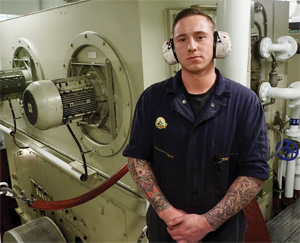 |
|
Puyallup is powered by four 4,000-hp EMD diesel engines paired with Siemens electric drive motors, shown behind oiler Jesse Sutton. |
“It is a beautiful thing,” said Edwards, who joined the ferry system about two years ago after working on tugboats and offshore supply vessels in the Gulf of Mexico. “There is no other maritime job that touches this as far as family life goes.”
There was relatively little traffic on Elliott Bay, but these waters can get extremely crowded during the summer with sailboats, powerboats, other ferries and workboats moving to and fro. Deep-draft commercial ships, bound for Seattle or Tacoma, bisect the routes between Seattle and Bainbridge Island and Seattle and Bremerton to the southwest. The Seattle-to-Bremerton run is the longest in the system at 17.5 miles. Seattle to Bainbridge Island is the busiest run overall. Its 6.2 million riders a year account for more than a quarter of all ferry system passengers.
Edwards eased off the throttles as the ferry made its hard turn to starboard near Tyee Shoal off Bainbridge Island. He continued to slow the ferry as it entered the narrows between Bill Point and Wing Point leading to the terminal in Eagle Harbor.
“We normally come in at about 9 or 9.5 knots,” Michelson said as Edwards steered for the landing. “This is fast for most people but it is common for us.” Edwards backed the engines to slow the ferry into position, pushing a massive amount of water forward as the ship slowed to a crawl.
Propulsion aboard each of the Jumbo Mark II ferries comes from a diesel-electric hybrid power system below the main passenger deck. Four 4,000-hp EMD diesel engines generate electricity through Kato alternators that can produce up to 3 million volts of power. All of that energy goes through Siemens electric motors that turn a single propeller on the fore and aft ends of the ship. The engine compartments are mirror images of one another with two mains and two electric motors.
Just three engines are used on most crossings to save fuel and reduce emissions. Even so, those big engines burn a lot of diesel. In a normal year, WSF vessels consume 18 million gallons of diesel fleetwide. Puyallup and its Jumbo Mark II sisters together use 5 million gallons, or 26 percent of the overall total.
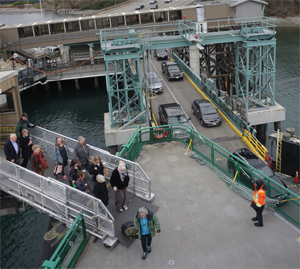 |
|
The ferry takes on passengers and vehicles at Bainbridge Island. WSF carries 6.2 million passengers a year on the Seattle-to-Bainbridge route. |
Those figures will almost certainly be lower in the years to come. WSF plans to install battery-electric hybrid propulsion systems aboard the Jumbo Mark II vessels during their upcoming 20-year engine replacement periods. Siemens won a contract to design the new system, which is still under development. Ferry officials expect the new propulsion package will reduce emissions by a quarter and cut operating costs by $14 million a year.
Separately, WSF has partnered with Vigor for the design and construction of up to five new hybrid-electric Olympic-class ferries. The vessels will run entirely in electric mode for most voyages. Construction of the first new ferry should begin within a year.
Until the conversions happen, the engineering crews aboard each Jumbo Mark II ferry must keep the older propulsion systems running. Puyallup alternate staff chief John McGarrity and his team monitor vessel performance from a control room sandwiched between the fore and aft engine compartments. The control panel, outfitted with numerous gauges and monitors, provides a real-time look at engine output and myriad other data sets.
“This is like an EKG of the boat,” assistant engineer Rick Hughes said as he gestured toward a series of monitors with lines that rise and fall depending on power demanded by the captain, power produced by the plant, and other metrics. When the engines are running optimally, the lines will rise or fall more or less in lockstep. “As long as these lines are getting along, I’m happy,” he said.
WSF engineers are assigned to a particular boat, and they stay with that boat even if its route changes. They work seven days followed by a week off, alternating weeklong day and night shifts. McGarrity and Hughes have each spent nearly two decades working aboard Puyallup. They have a genuine admiration for the vessel, and their efforts have gotten plenty of attention over the years. Plaques honoring the ferry’s near-perfect service record line the control room walls.
“Our reliability is off the charts,” McGarrity said. “We haven’t missed a trip in eight years.”
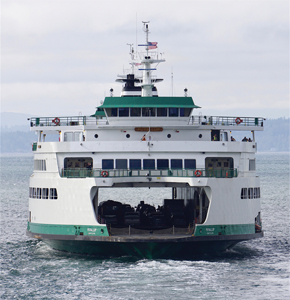 |
|
Puyallup leaves Colman Dock in Seattle with a relatively light lunchtime load. The ferry, named for a Native American tribe in Washington, has earned numerous awards for reliability. |
For the engineering crew, that statistic is the ultimate measure of their work. Michelson, as captain, feels a similar responsibility to keep the ferries running exactly on time. Early-morning runs typically have 1,000 or more passengers, nearly all of whom are headed to work in Seattle. Arriving a minute or two late can mean the difference between riders catching or missing transit connections to get to work on time. Afternoon commutes carrying people back home are similarly busy.
“We don’t miss a lot of trips … and we are pretty much on time for the most part,” Michelson said, with the caveat that countless factors, most out of the ferry system’s control, can slow things down. “For the community it is important we keep on time. That is our number-one job, to get people to work on time.”
Right on schedule, Michelson prepared to guide Puyallup east across Elliott Bay back to Seattle. He was joined in the forward wheelhouse by quartermaster Tommy Gall, who executed the captain’s speed and course changes through the S-turn leading out of Eagle Harbor. Michelson paid close attention to TOTE Maritime’s Midnight Sun on the Furuno radar as the cargo ship, bound for Tacoma, approached from the north.
“I see it,” Gall said of the 839-foot roll-on/roll-off vessel.
“He’s screaming,” Michelson said. “He is making 21 knots. That is about the fastest deep-draft traffic we’ll see around here.”
Michelson adjusted his crossing plan to account for the approaching ship, noting that there is “no cookie-cutter way” to make the transit. Gall, following Michelson’s commands, steered alongside Bainbridge Island before turning sharply to port to line up with downtown Seattle. Puyallup made about 13 knots, a little faster than normal, to keep plenty of distance from Midnight Sun before speeding up to the ferry’s usual 18 knots.
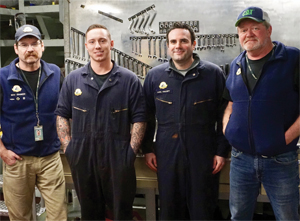 |
|
Serving on the four-person dayside engineering crew are, from left, assistant engineer Rick Hughes, oilers Jesse Sutton and Dan Kelly, and alternate staff chief John McGarrity. |
The cargo ship ultimately passed roughly two miles behind Puyallup, while the Centerline Logistics tugboat C.E. towed the fuel barge Professor Karen Ann Brown well in front of the ferry’s path. The westbound WSF vessels Chimacum, heading for Bremerton, and Tacoma, bound for Bainbridge Island, both passed on Puyallup’s starboard side. Tacoma’s route was a little farther north than usual, pushing Puyallup a little farther north as well.
Michelson got the call about the passenger’s seizure as the ferry approached downtown Seattle. He increased speed, and kept the ferry’s speed up, to get the passenger medical attention as soon as possible. The additional speed also provided a little relief from the 15- to 20-knot wind gusts.
“The main thing I am thinking about now is that wind,” the captain said as he lined up with the terminal. “With that side wind (from the south) and this huge sail area, when I get down to about 3 or 4 knots it is really going to start pushing me to the north. So I set it way to the south so the wind, with the boat and the steering, will set me into the dock.”
Michelson approached the landing at 2 or 3 knots before putting the forward engines astern, sending a torrent of whitewater ahead of the bow. The ferry eased into position with barely a nudge against the dock. Crews rapidly mobilized to ensure the seizure victim could be seen by paramedics, which delayed offloading vehicles by 10 or 15 minutes.
The westbound voyage back to Bainbridge Island would be a little late getting underway. But for a ferry service that makes thousands of runs each year, carrying millions of people and vehicles, the occasional hiccup is unavoidable.

